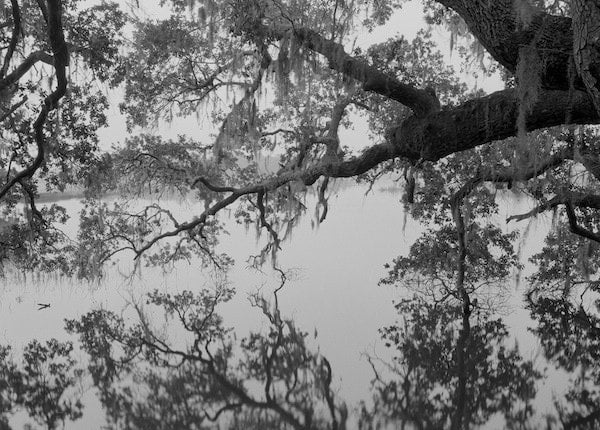
Chances are, you already know the work of Low Country photographer Jack Leigh. He provided the iconic “Bird Girl” image for the cover of Midnight in the Garden of Good and Evil. This one image perfectly encapsulates the Southern Gothic tale of Midnight, and helped keep the novel on the New York Times Bestseller List longer than any other. But beyond this one iconic image, Leigh, who died in 2004, is not very well known outside of the Southern photography scene. While his contemporaries William Eggleston and William Christenberry traversed the South, Leigh stayed focused on his native Savannah. “The Spirit of the Place: Photographs by Jack Leigh,” on view at the High Museum of Art through June 11, presents the life and legacy of Leigh—including and beyond “Bird Girl.” All of the photos in this show are classic silver gelatin prints—Leigh was a classically trained photographer and never ventured into the world of color.
Leigh focused his attention on the Low Country, and his subject matter often included marshlands, oystermen, Spanish moss, and coastal waters. What makes Leigh’s work so distinctive is his use of shadow. Specifically, he portrays his subjects using darkness, rather than light. The tonality of his images leans towards large swaths of gray with very subtle differentiation. Most black-and-white photographers focus on light and contrast to create an image (think Ansel Adams), but Leigh expresses his vision in a moody, toned down manner. In a way, this reflects the experience of being in the Low Country—dark swamps shrouded in trees and moss. The details are in the darkness.
Ossabaw Creature perfectly encapsulates Leigh’s moody photographic vision. The creature is a driftwood tree on the Ossabaw Island beach, its body reflected in a shallow pool of water. The tree is dark and brooding—the shadows of the bark give it a malevolent feel. The horizon line is a very small strip of light that separates sky from land. The water, sand, sky, and clouds are almost all the same tones of gray. Only the textures of the different elements make them stand apart. This work is not about the grandeur of nature or finding beauty in the light. Leigh seems preoccupied with a darker vision of coastal Georgia.

The Bird Girl image is also on view. Again, this work, which Leigh titled Midnight, speaks to Leigh’s interest in finding details in the darkness. The image was shot in Savannah’s famous Bonaventure Cemetery, which readily lends itself to shadowy and foreboding photography. The canopies of oaks and moss seem to cover the entire cemetery. The stone statues of Bonaventure are left to gather dirt and grime. The entire place has an air of decay, which Leigh seized on in this image. The Bird Girl statue appears to be lit by an unnatural light; she comes forward from the tangles of moss and dirt surrounding her. Leigh manipulated this image in the darkroom, using a technique called “dodging” where the area directly on the bird girl is underexposed, and the surroundings are overexposed. This created a scene that was completely unlike reality. On another technical note, the Bird Girl appears much larger in the photo than she is in real life (it’s on display at the Jepson Museum in Savannah, and is surprisingly only about 4 feet tall). Leigh used a telephoto lens to compress the space around her to make her appear larger than life. Leigh’s use of techniques like this speak to his mastery of black-and-white photography.
Even Leigh’s images of human subjects focus on darkness. His portrait Oysterman at Night is, naturally, enveloped in pure blackness. A fire can on the edge of the boat lights the scene and provides stark illumination for the image. The water, the boat, the oysters, and the oysterman are all the same dark shades of gray, the parts again differentiated by texture. In Savannah Saw Works, a woman walks past a sign for a blade sharpening business. The shadow she casts on the ground is not very large, indicating that it must be close to high noon. She even carries an umbrella to shield herself from the sun. Despite these indications that it was bright when Leigh took the photo, there is no area of pure white in the image. It’s all black and dark grays, with texture breaking up the image.
Leigh’s view of the spirit of the Low Country was obviously a dark and mysterious one. This is not some sun-drenched and wide-open South as seen by Christenberry and Eggleston. Leigh saw spaces closed off, a world more secretive, removed from the modern day. Decaying. He truly captured the spirit of this place called the Low Country.




